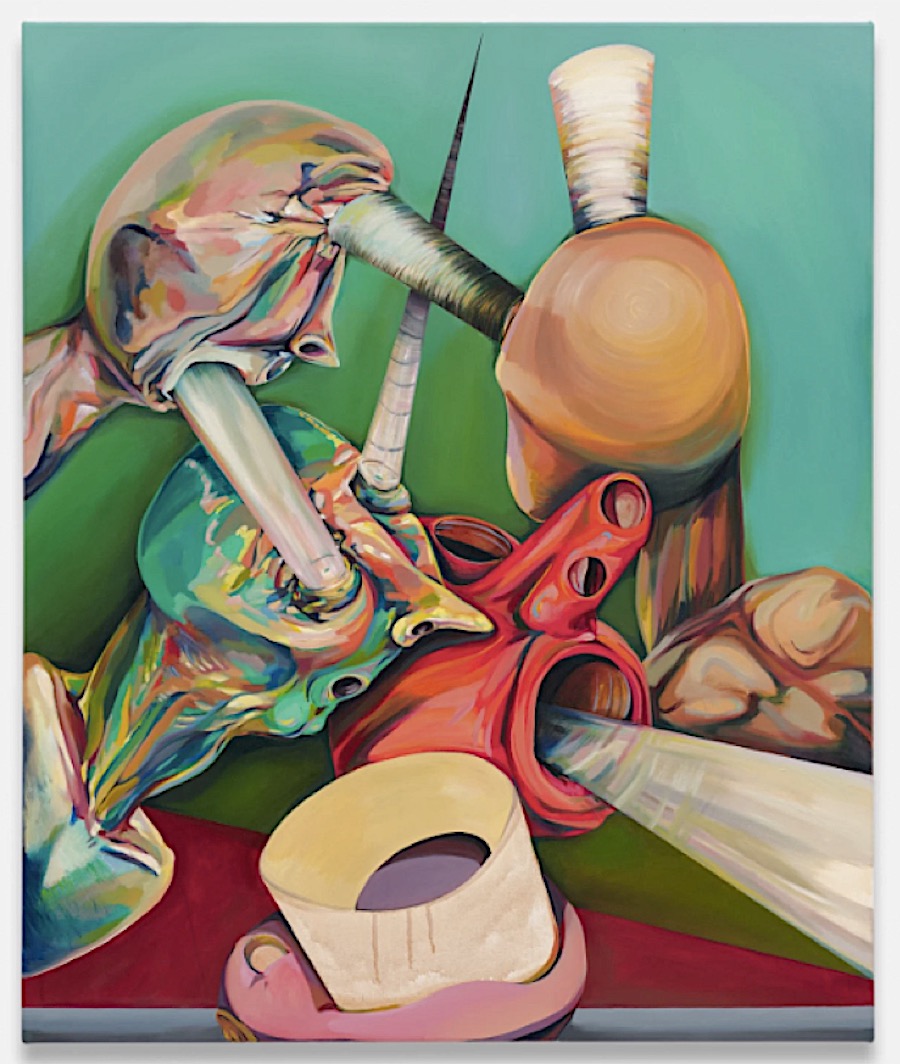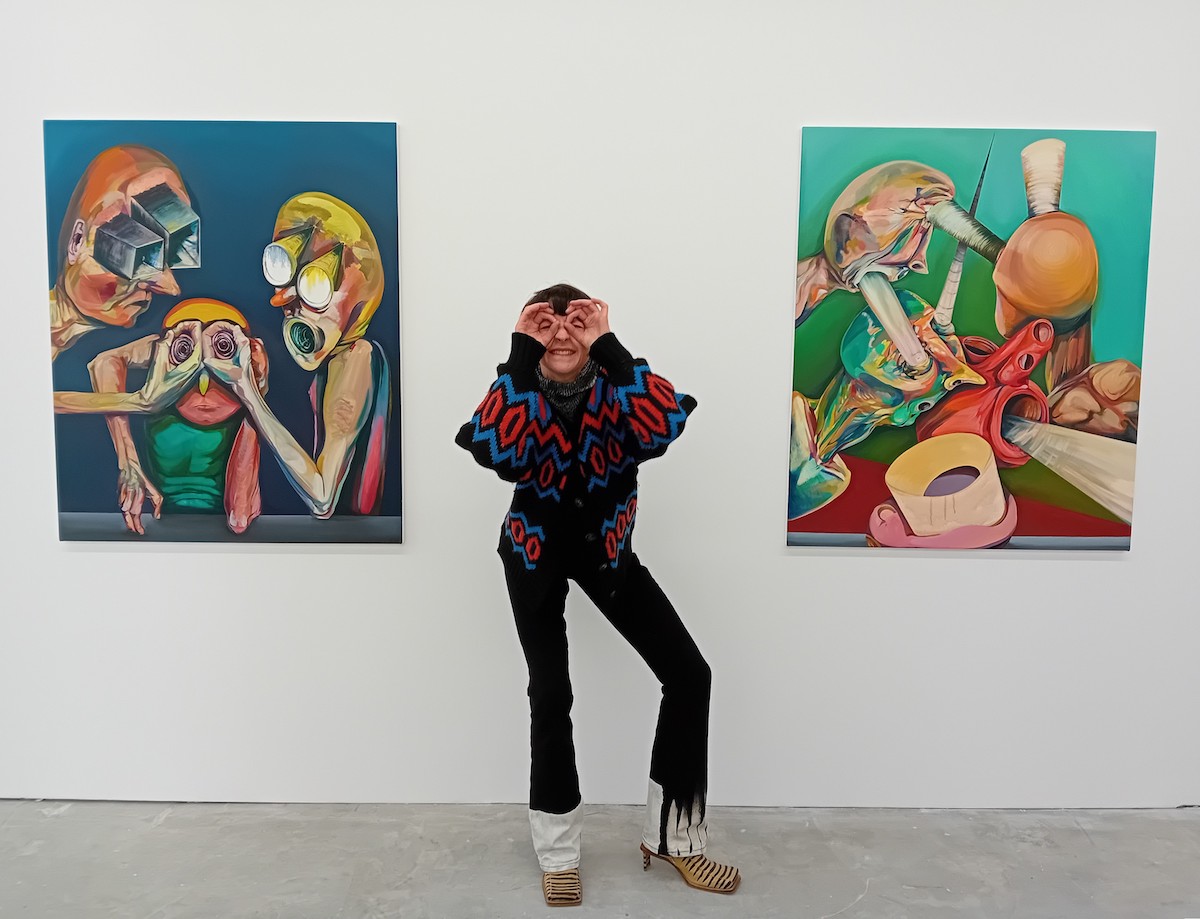Emma Cousin’s show ‘Tunnel Vision’ is the first in Niru Ratnam’s new space in Fitzrovia. The vibrant paintings were made either side of her giving birth in late 2022, and that experience is central to the figures who populate them. Not only do they perceive the world with the intensity of focus – or tunnel vision – that motherhood and art-making can both engender, they are revealed as incorporating interior tunnels in line with the enhanced awareness that Cousin found pregnancy bringing to her own interior structure. As ever, her work is fizzing with ideas…
What is ‘tunnel vision’?
Tunnel vision is the loss of peripheral perception with retention of central sight, resulting in a constricted, circular, tunnel-like field of vision. Goggles, glasses, and binoculars as well as medical illnesses are physical causes. For me, morning sickness felt like tunnel vision, everything apart from what I was directly looking at felt sickly. Painting through this lens was focusing and challenging. Psychologically, tunnel vision is when individuals focus on cues that are consistent with their opinion and filter out cues that are inconsistent with their viewpoint. In a political context, that can be negative. But this obsessive focus, where everything else falls away, is a mindset of funnelling that is useful in the studio.

‘Tsog’, 2023 – Oil on canvas, 140 x 120 cm
All the figures seem to combine a ‘tunnel vision’ way of perceiving the world with an awareness of their inner structure of tunnels, but does ‘Tsog’ concentrate mainly on the internal aspect?
Perhaps… That’s about bringing the body back together, tunnelling inside, working out where how the tunnel would end – something comes out and you have to close the tunnel somehow. That’s the first time I’ve put figures in the background. They’re from Rembrandt’s ‘The Anatomy Lesson’, but they’re not watching the body being dissected, they’re watching how it’s put back together. It relates to my own body after birth: how to reassemble myself, how to deal with the void of the tunnel that had been filled. I imagined tunnelling to meet the baby, though of course you can’t – the baby tunnels towards you. But psychologically you do think like that, so it’s the union of inside and outside experiences. I was also thinking about tunnelling into yourself, to do with post-natal anxiety, when all the thoughts pile up like soil. Or how something was cut away, but to make something more beautiful. Beautiful and maybe gross at the same time. It’s like I’ve been inside-out for a bit! What would the flesh inside look like, and what would the flesh outside look like? It’s kind of amazing to have someone’s body inside you, and makes you aware of how much space there is inside you, and how you’re rejigged after having a baby. The way I’ve come back together is better than before in some ways – more efficient digestion!
What’s a tsog?
That’s a tool you use to cut peat. It looks like an extension of the body, fitting well within the hand. It works like a trowel, but also slices – that’s quite a brutal act but it creates these perfect bricks of geometry – an architecture of the land. That comes from remembering a holiday in the Outer Hebrides where I had watched peat cutters delve into the turf and hefting, turning, and laying out wedges of the inner soil in neat rows along the cleft they had cut into. They tunnelled into the earth and laid out its damp inner parts in tidy layers like sedimentary rock, each layer a slightly different tone of brown-black. After the birth, I saw an osteopath who described connecting me back together in slices, like a landscape that had become dislocated. So this painting is also about earth, sustenance, and pigment – thinking of how Rembrandt ground his own colours.

‘Den or Cornetto’, 2023 – Oil on Canvas, 120 X 100 cm
The tunnel as a constraint on viewing is prominent in ‘Den or Cornetto’. What’s going on there?
I was thinking about dens as in tunnels, and how they might be built. Cornetto could be some version of a cone as used in ice-creams – sharp end, open top; or the cornet instrument, that uses pistons to trap air; or the shape, like a possible puncturing tool. I was thinking about: where do you get your vision? I heard of a writer who eats as he writes so that his gut can play a role – activating an organ to feed his writing as if it were an engine. So maybe the tunnel of vision could be from the mouth, the mouth could be a portal to other realms. It’s a bit sci-fi: could you reverse the seeing process? The eyes are blinded but the mouth sees…
Is there something of a child’s playfulness in that?
As a kid I remember collecting empty toilet rolls to build things with. These redundant tubes, once heavily sellotaped and connected, could morph into limb augmentations, eye extenders and viewfinders, often becoming absurd glasses or rudimentary telescopes. Attaching them to eyes or mouth, sound could be carried further, and it seemed sight could be supplemented. I rehearsed this in the studio with two sawn-off tubular poles I had found. I felt like a horse wearing blinders in traffic, fixed and dangerous, externally oblivious.
Does your baby’s own ‘tunnel vision’ come into the show?
Yes! Early in the pregnancy, I read that the baby has tunnel vision in the womb, and reading about their sight development and understanding of object permanence in science and child psychology reference books is fascinating and very weird. After the birth I was reading ‘Diary Of A Baby: What Your Child Sees, Feels, And Experiences’ (Daniel Stern, 1990) which describes the development of a baby from the baby’s point of view.
Who’s that in the detail from ‘Dogger, Rockall and Malin’?
That’s me inside myself, painting myself with myself (my guts, thoughts, feelings etc). I put myself in a cave, embracing where I was with all these tunnels. It’s a literal depiction of the outside-inside. I did visit some caves and tunnels for real. Stalagmites and stalactites are always crazily lit, so they look toxic. And they look like gut systems…
Installation view with ‘hmeep hmeep’, 2024 Photo: Damian Griffiths (the title comes from how the film’s sound creator, Paul Julian, spelt Road Runner’s version of ‘beep beep’)

You’ve also made a mural that channels another tunnel inspiration from the violent comedy of the ‘Road Runner’ cartoons. Could you tell us about that?
The Looney Tunes cartoons feature the painted tunnel as one of Wile E. Coyote’s stunts to trick the Road Runner. In the episode ‘Fast and Furry-ous’ (1949), Coyote paints a tunnel onto a rock, instantly giving the optical illusion of an open tunnel, then lays in wait for the Runner. To Coyote’s chagrin, Road Runner ploughs on through the imaginary tunnel, confounding Coyote. He then takes a run-up to the painted tunnel and smacks hard into the rock face, bouncing off, dazed and comedically crumpled like an accordion. It’s shocking how quickly you can create an illusion like that, and there’s a slapstick pleasure to it. In March 2016, Yahoo News reported that a street artist had recreated Wile E. Coyote’s fake painted tunnel so successfully that a Fiat drove into the wall on which it was painted!
Recreating Coyote’s tunnel in the studio to better understand it, I appreciated that taking on ‘tunnel vision’ could be a way out of my stuckness, faced with an empty studio – the idea of tunnel vision could become an escape route for me, like Road Runner. The tunnel is based on a screenshot from the cartoon. I wanted the surrounding figures to be spontaneous, to be playing with where things could go, where they could tunnel, and what depth of the tunnelling metaphor I could get away with.
Top Photo: Emma Cousin demonstrating ‘tunnel vision’ © Courtesy of the Artist
‘Tunnel Vision’ runs 18 Jan – 24 Feb at Niru Ratnam, 71-73 Great Portland Street, London W1W 7LP. Cousin’s 2,000-word artist’s statement is available there, and I recommend it for a fuller exploration of all things tunnel vision.

